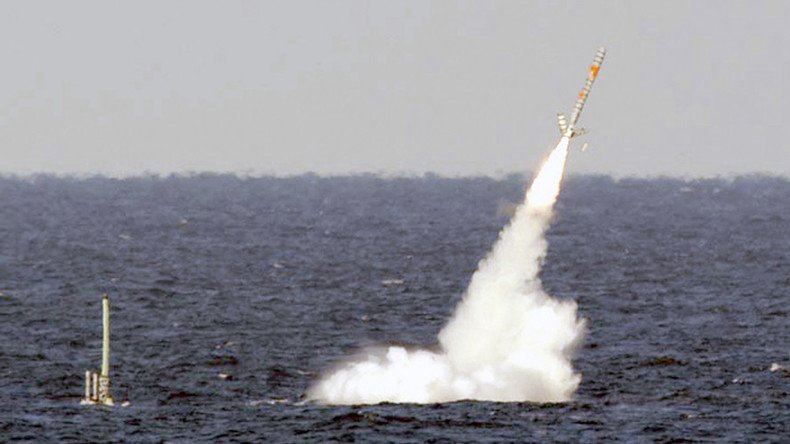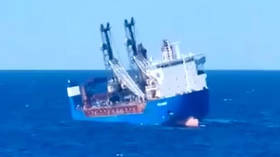Daunted by Russia & China, US Navy scrambles to repurpose missiles as ship-killers

The US Navy wants to equip its fleet with ship-killing variants of currently used anti-air and cruise missiles, citing new capabilities developed by Russia and China. However, the new missiles may not be ready until the next decade – at best.
One of the Pentagon’s requests from Congress in the 2017 budget proposal is $434 million to upgrade about 250 Tomahawk land-attack cruise missiles (TLAM) so they can be used against ships as well. The modified missiles would have the range of up to 1,000 nautical miles (1852 km), the US Naval Institute reported.
Surprise! The U.S. Navy Has a New Ship-Killing Missile - https://t.co/SLJPcIhtSs#army#militarypic.twitter.com/npgHrTWOEw
— Army Complex (@ArmyComplex) February 14, 2016
“It won’t be all the Tomahawks but a good number of them coming off the line will have it,” Vice-Admiral Joseph Mulloy, Deputy Chief of Naval Operations, told USNI on Wednesday. “It’s going for surface first and the submarines will encapsulate it.”
The US Navy’s primary ship-killer is the RGM/UGM-84 Harpoon, developed in the 1970s by McDonnell-Douglas, now owned by Boeing. Capable of being fired from airplanes, surface ships and submarines, the Harpoon’s primary shortcoming is its very short range – less than 70 nautical miles (130km).
READ MORE: China deploys 3rd stealth cruise missile destroyer
Modifying the Tomahawk would give extended-range anti-ship capabilities to the Ticonderoga-class guided missile cruisers, Arleigh Burke-class destroyers, all of the attack submarines and the four Ohio-class subs (SSGN) that had been converted from their ballistic role in the 2000s.
Another McDonnell-Douglas design, the BGM-109 Tomahawk first entered service in 1983, and has been used in combat since the 1991 Gulf War. An anti-ship version (UGM-109) was withdrawn from service in 1994, because its sensors were not good enough to ensure hitting a moving target. The land-attack Tomahawks are currently being built by Raytheon.
In January 2015, however, a Naval Air Systems command (NAVAIR) conducted a test and showed that an airplane could guide the Block IV version of the Tomahawk into hitting a moving ship. Following the test, Deputy Defense Secretary Robert Work called the prospect of a modified anti-ship Tomahawk “a game-changing capability.”
In addition to the modified Tomahawks, the Navy is looking to adapt the Standard Missile 6, another Raytheon product, for use against ships. The SM-6 (also known as the RIM-174) entered service in 2013 as an air defense missile.
"We are going to create a brand-new capability," Defense Secretary Ash Carter said during a February 10 press conference in San Diego, California, a major Navy hub. “We're modifying the SM-6 so that in addition to missile defense, it can also target enemy ships at sea at very long ranges.”
The SM-6 has a published range of 150 miles (240 km), but Carter said the anti-ship version would be able to hit targets “200 miles away.”
There are no plans for the modified SM-6 to have a different warhead than its air-interceptor cousin, Raytheon’s program director Michael Campisi told Popular Mechanics. "SM-6 is a multi-mission missile," he said. "One configuration performs all missions."
It remains a mystery how Raytheon and the USN intend to use a blast-fragmentation warhead designed to destroy incoming missiles and aircraft against a surface ship. By contrast, the Harpoons have a 488-pound (221 kg) contact warhead.
Furthermore, tests showed that both the Tomahawks and the SM-6 currently need to be guided to their targets by aircraft, which are themselves vulnerable to interceptors and missiles.
The Navy is currently relying on a stopgap shipment of DARPA’s stealthy long-range anti-ship missiles (LRASM), the AGM-158C. Fewer than 100 have been ordered, and they are expected to become operational in 2018 or 2019.
Last year, China publicly showed off its Dongfeng (“East Wind”) DF-21D missile, which some US observers have dubbed a “carrier killer.” The anti-ship ballistic missile has a maximum range of 780 nautical miles, or 1,450 km, and there is currently no defense against it.
Meanwhile, the Russian Navy demonstrated its cruise-missile capabilities as well, launching a volley of 3M14T Kalibr missiles in October 2015 against Islamic State (IS, formerly ISIS/ISIL) targets in Syria. According to the Russian Defense Ministry, the missiles are capable of hitting a target at a range of up to 2,500 kilometers with 3-meter accuracy.













